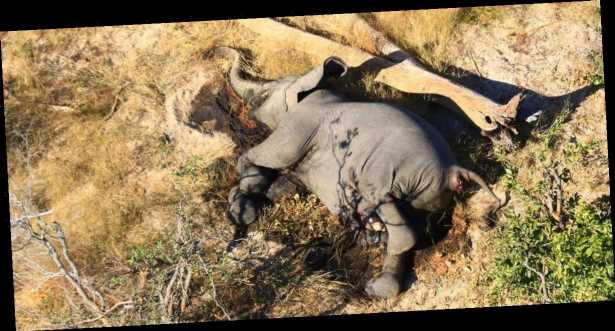- At least 330 elephants have been found dead in Botswana since May.
- After months of investigation, researchers have figured out the elephants died because their drinking water was contaminated with toxic cyanobacteria, or blue-green algae.
- As the world warms, such toxic blooms are expected to proliferate.
- Visit Business Insider's homepage for more stories.
Since May, hundreds of elephants near Botswana's Okavango Delta died suddenly and inexplicably.
"Conservationists on the ground have reported horrific scenes of dying elephants walking around in circles, and others dying flat on their faces," Mark Hiley, co-founder of the conservation organization National Park Rescue, told Business Insider in July.
Researchers considered many possible explanations for the mass die-off — was it poaching? Poison? COVID-19? But they weren't able to pinpoint the pachyderms' cause of death until now.
On Monday, Botswana officials announced the killer: "Our latest tests have detected cyanobacterial neurotoxins to be the cause of deaths. These are bacteria found in water," Mmadi Reuben, the principal veterinary officer of Botswana's Department of Wildlife and National Parks, said in a press conference.
The cyanobacteria, also called blue-green algae, bloomed in local watering holes.
The algae's toxins affect both humans and animals — they can be inhaled, swallowed, or seep through the skin, leading to gastrointestinal problems, paralysis, and even death in dogs, fish, and cattle.
Hundreds of dead elephants
At least 330 elephants have died in Botswana since the spring.
To figure out what killed them, researchers studied samples collected from the elephant carcasses for months across labs in South Africa, Zimbabwe, Canada, and the US.
Initially, officials dismissed the idea that algae blooms were fueling the elephant die-off, since no other animals — even the hyenas that ate the dead elephants — in the Okavango Delta died en masse. Elephants in other parts of the country remained healthy, too.
But around 70% of the deaths occurred near watering holes containing algal blooms, according to The Guardian — compelling evidence for the conclusion that cyanobacteria is indeed to blame. The die-off also seemed to end in June, after the poisoned watering holes dried up during the area's dry season.
The physiological effects of cyanobacteria align with what researchers observed among elephants in the Okavango. Some of the animals lost control over their motor functions, a clue that toxins were affecting the animals' nervous systems, Hiley said.
Deadly algae blooms are spurred by climate change
When algae multiplies quickly, it can form a layer of scum on the surface of ponds, lakes, and even oceans — that's called a bloom.
The trigger behind these specific toxic blooms, as well as the reason elephants were hardest hit, are mysteries officials have yet to solve.
"We have many questions still to be answered such as why the elephants only and why that area only," Reuben said. He added that researchers have several hypotheses, but didn't elaborate on them.
One guess, according to The Guardian, is that elephants are more susceptible to the algae's effects than other animals because they spend more time bathing in watering holes and drink larger quantities of water.
Researchers also know that in general, toxic algae proliferates faster when the water it lives in is warm and rich in nutrients like phosphorus and nitrogen. These chemicals can come from fertilizer runoff.
"It amounts to having the right conditions, in the right time, in the right place, and these species will proliferate," Patricia Glibert, an environmental scientist who has studied cyanobacteria, told Reuters.
As the planet warms, scientists expect such blooms to occur more often.
Temperatures in southern Africa are rising twice as fast as the global average, so it's likely the number of cyanobacteria blooms in Botswana will continue increasing.
"These conditions are coming together more often, in more places, so we are seeing more of these toxic blooms around the world," Glibert added.
That means toxic algae could easily plague elephants again in the future.
"It is important to monitor now to effectively detect the growth of these algal blooms in the water," Reuben said.
Ecotourism is the second-biggest sector of Botswana's economy, second only to diamonds, Hiley previously told Business Insider, so it's especially important that officials keep tabs on potential cyanobacteria outbreaks to prevent another mass die-off.
"It's one of the biggest disasters to impact elephants this century, and right in the middle of one of Africa's top tourism destinations," he said.
Botswana is home to around 130,000 elephants, the largest chunk of Africa's elephant population. However, that number is decreasing sharply; the animals were classified as vulnerable in 2016.
Mia Jankowicz contributed reporting to this story.
Source: Read Full Article
